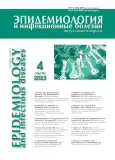Crimean hemorrhagic fever and Astrakhan spotted fever: epidemiology, clinic, system of mathematical models for predicting the manifestations of the epidemic process
- Authors: Ugleva S.V.1, Akimkin V.G.1
-
Affiliations:
- Protection and Human Well-Being
- Issue: Vol 13, No 4 (2023)
- Pages: 62-72
- Section: Original Investigations
- Published: 31.12.2023
- URL: https://journals.eco-vector.com/2226-6976/article/view/625532
- DOI: https://doi.org/10.18565/epidem.2023.13.4.62-72
- ID: 625532
Cite item
Abstract
Objective. Clinical and epidemiological characteristics and development of a system of models for predicting the manifestations of the epidemic process of Crimean hemorrhagic fever (CHF) and Astrakhan spotted fever (ASF) using the example of the Astrakhan Region.
Materials and methods. We used data from primary medical documentation (Form №. 058/u), federal statistical monitoring forms (forms № 2, № 357/u, №. 003/u) for 2000–2020 and materials from long-term observation of disease outbreaks in 11 districts of the Astrakhan Region and the city of Astrakhan. Absolute and intensive morbidity rates depending on age and occupational groups, as well as among urban and rural population were studied. Based on the average long-term morbidity rates of the population, mapping of the region’s territory was carried out. The influence of natural and climatic conditions on the epidemic process of CHF and ASF using meteorological data (amount of precipitation, air temperature, etc.) was assessed.
Results. Mathematical models for predicting the manifestations of the epidemic process of CHF and ASF, taking into account the multifactorial influence of abiotic (average air temperature and amount of precipitation during the seasonal increase in incidence) and biotic (the abundance ratio of ixodid ticks) factors that determine the CHF and ASF incidence rate in the population have been developed. Models with a high (more than 80%) degree of accuracy make it possible to develop a short-term forecast of the epidemic situation depending on the epidemiological risk for territories in a certain period of time.
Conclusion. Based on the results of a long-term comprehensive study of the epidemiological characteristics and clinical manifestations of CHF and ASF, recommendations for optimizing their prevention, based on the use of a mathematical model for predicting the manifestations of the epidemic process were given.
Full Text
About the authors
Svetlana V. Ugleva
Protection and Human Well-Being
Author for correspondence.
Email: uglevas@bk.ru
ORCID iD: 0000-0002-1322-0155
МD, Associate Professor, Head, Scientific and Analytical Department; Professor, Department of Epidemiology with Courses in Molecular Diagnostics and Disinfectology
Russian Federation, MoscowVasily G. Akimkin
Protection and Human Well-Being
Email: vgakimkin@yandex.ru
ORCID iD: 0000-0003-4228-9044
Academician of the Russian Academy of Sciences, MD, Professor, Director
Russian Federation, MoscowReferences
- О состоянии санитарно-эпидемиологического благополучия населения в Российской Федерации в 2020 году: Государственный доклад. М.: Федеральная служба по надзору в сфере защиты прав потребителей и благополучия человека, 2021. 256 с. https://www.rospotrebnadzor.ru/ documents/details.php?ELEMENT_ID=18266 [On the state of sanitary and epidemiological well-being of the population in the Russian Federation in 2020. State report]. Moscow. 2021. 256 p. (In Russ.). https://www.rospotrebnadzor.ru/documents/details.php? ELEMENT_ ID=18266
- Куличенко А.Н., Малецкая, О.В., Прислегина Д.А., Махова В.В., Таран Т.В., Василенко Н.Ф. и др. Эпидемиологическая обстановка по природно-очаговым инфекционным болезням в Южном и Северо-Кавказском федеральных округах в 2021 г. (Аналитический обзор). Ставрополь: ООО «Губерния», 2022. 96 с. Kulichenko A.N, Maletskaya O.V., Prislegina D.A., Makhova V.V., Taran T.V., Vasilenko N.F., Manin E.A. et al. [Epidemiological situation on natural focal infectious diseases in the Southern and North Caucasian federal districts in 2021 (Analytical review)]. Stavropol: Gubernia LLC, 2022. 96 p. (In Russ.)
- Углева С. В., Шабалина С. В. Риккетсиозы в регионе Нижнего Поволжья. Журнал микробиологии, эпидемиологии и иммунобиологии 2021; 98(2): 231–8. DOI: https://doi.org/10.36233/0372-9311-60 Ugleva S.V., Shabalina S.V. [Rickettsioses in the Lower Volga Region]. Journal of Microbiology, Epidemiology and Immunobiology 2021; 98(2): 231–8. (In Russ.). DOI: https://doi.org/10.36233/0372-9311-60
- Углева С. В., Акимкин В.Г., Понежева Ж.Б., Ахмерова Р.Р., Спиренкова А.Е., Черникова Ю.Ю., Шабалина С.В. Эпидемиологическая общность и различия актуальных для Астраханской области трансмиссивных инфекций. Эпидемиология и Вакцинопрофилактика 2021; 20(6): 63–71. 10.31631/2073-3046-2021-20-6-63-71' target='_blank'>https://doi: 10.31631/2073-3046-2021-20-6-63-71 Ugleva S.V., Akimkin V.G., Ponezheva Zh.B., Akhmerova R.R., Spirenkova A.E., Chernikova Yu.Yu., Shabalina S.V. [Epidemiological Community and Differences of Transmissive Infections in Astrakhan Region]. Epidemiology and Vaccinal Prevention 2021; 20(6): 63–71. (In Russ.). https://doi: 10.31631/2073-3046-2021-20-6-63-71
- Галимзянов Х.М., Углева С.В., Василькова В.В., Лунина И.О. Атлас переносчиков природно-очаговых трансмиссивных инфекций. Астрахань: Астраханский государственный медицинский университет 2015. 100 с. Galimzyanov Kh.M., Ugleva S.V., Vasilkova V.V., Lunina I.O. [Atlas of vectors ofatural focal transmissible infections]. Astrakhan: Astrakhan State Medical University, 2015. 100 р. (In Russ.).
- Онищенко Г.Г., Куличенко А.Н. (ред.). Крымская геморрагическая лихорадка. Воронеж: Фаворит, 2018. 288 с. Onishchenko G.G., Kulichenko A.N. (eds.). [Crimean hemorrhagic fever]. Voronezh: Favorit, 2018. 288 p. (In Russ.).
Supplementary files






